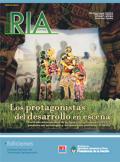Ver ítem
- xmlui.general.dspace_homeCentros Regionales y EEAsCentro Regional Buenos Aires SurEEA BalcarceArtículos científicosxmlui.ArtifactBrowser.ItemViewer.trail
- Inicio
- Centros Regionales y EEAs
- Centro Regional Buenos Aires Sur
- EEA Balcarce
- Artículos científicos
- Ver ítem
Efecto de la fertilización nitrogenada en soja intersembrada en trigo en Balcarce
Resumen
Es sabido que la soja intersembrada en trigo tiene bajo crecimiento inicial, lo cual podría afectar negativamente la formación de nódulos fijadores de nitrógeno (N) y limitar el crecimiento de la soja luego de la cosecha del trigo. En este trabajo se propuso: (i) corroborar si soja intersembrada en trigo tiene respuesta a la fertilización nitrogenada y (ii) evaluar la dosis de N óptima de una soja intersembrada. Se condujeron dos experimentos de soja
[ver mas...]
Es sabido que la soja intersembrada en trigo tiene bajo crecimiento inicial, lo cual podría afectar negativamente la formación de nódulos fijadores de nitrógeno (N) y limitar el crecimiento de la soja luego de la cosecha del trigo. En este trabajo se propuso: (i) corroborar si soja intersembrada en trigo tiene respuesta a la fertilización nitrogenada y (ii) evaluar la dosis de N óptima de una soja intersembrada. Se condujeron dos experimentos de soja intersembrada en trigo bajo riego en Balcarce, con tratamientos de niveles de fertilización nitrogenada. En el primer año los niveles de fertilización fueron cero y una dosis equivalente a los requerimientos de N del cultivo (530 kg N ha-1). En el segundo año se evaluaron cuatro niveles de fertilización calculados como una proporción de la dosis de indiferencia (204 kg N ha-1): 0, 51, 102 y 204 kg N ha-1. A la madurez del cultivo de soja, se midió rendimiento, índice de cosecha, peso/grano, peso seco total y número de granos m-2. Los resultados obtenidos muestran que existieron respuestas significativas de la soja a la fertilización nitrogenada. Bajas dosis de N (equivalentes a 1/4 de la dosis de indiferencia) fueron suficientes para maximizar el rendimiento. Ambos experimentos confirman que el aumento de rendimiento a causa del N aplicado generó un incremento en el aporte de biomasa al sistema.
[Cerrar]
It is known that soybean intercropping in wheat has low initial growth, which could affect negatively the formation of nodules and limit the soybean growth after harvest of wheat. In this paper we proposed to: (i) confirm whether soybean-wheat intercropping has response to nitrogen fertilization and (ii) evaluate the optimum N rate of soybean intercropping. Two experiments were conducted in wheat-soybean intercropping irrigated crops in Balcarce, with
[ver mas...]
It is known that soybean intercropping in wheat has low initial growth, which could affect negatively the formation of nodules and limit the soybean growth after harvest of wheat. In this paper we proposed to: (i) confirm whether soybean-wheat intercropping has response to nitrogen fertilization and (ii) evaluate the optimum N rate of soybean intercropping. Two experiments were conducted in wheat-soybean intercropping irrigated crops in Balcarce, with treatments of nitrogen fertilization. In the first year fertilization levels were zero and 530 kg N/ha (equivalent to N requirement of soybean). In the second year we evaluated four fertilization levels calculated as a proportion of the dose of indifference (204 kg N ha-1): 0, 51, 102 and 204 kg N ha-1. At maturity yield, harvest index, weight per grain, total crop dry weight and number of grains m-2 were measured. Results show significant responses of soybean to nitrogen fertilization: low N doses (equivalent to 1/4 of the dose of indifference) were sufficient to maximize crop performance. Both experiments confirm that soybean yield increases by applied N increased biomass returns to the system
[Cerrar]

Fuente
RIA, 40 (1) : 54-59
Fecha
2014-04
Editorial
Gerencia de Comunicación e Imagen Institucional, DNA SICC, INTA
ISSN
1669-2314
Formato
pdf
Tipo de documento
artículo
Palabras Claves
Derechos de acceso
Abierto
 Excepto donde se diga explicitamente, este item se publica bajo la siguiente descripción: Creative Commons Attribution-NonCommercial-ShareAlike 2.5 Unported (CC BY-NC-SA 2.5)
Excepto donde se diga explicitamente, este item se publica bajo la siguiente descripción: Creative Commons Attribution-NonCommercial-ShareAlike 2.5 Unported (CC BY-NC-SA 2.5)


